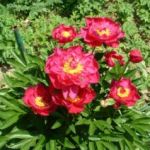| Common Name: |
Chinese Peony |
| Botanical Name: |
Paeonia lactiflora syn. P. albiflora |
| Genus: |
Paeonia |
| Family: |
Paeoniaceae |
| Native Location: |
Tibet to N and W China, Mongolia, and E Siberia. |
| Cultivation: |
Rich, well-drained soil in sun or partial shade, avoiding early morning sun, which may cause damage after frost. Remove dead wood from P. suffruticosa in early spring. Shoots and buds may be damaged by peony wilt (gray mold blight). Foliage may be damaged by leafspot and virus diseases. Buds and stem bases may be affected by Botyrtis. Susceptible to nematodes. |
| Propagation: |
By seed sown in autumn (species only); by division in autumn or early spring; by root cuttings in winter (P. lactiflora and P. officinalis); by layering or semi-ripe cuttings in spring, or grafting in winter (P. suffruticosa). Seed may take 2-3 years to germinate. |
| Harvest: |
Roots (P. lactiflora) are lifted from cultivated plants 4-5 years old, in late summer to mid-autumn, and boiled and dried for use in decoctions, pills, powders; wild plants are lifted in spring or (preferably) autumn and sun-dried. Roots (P. officinalis) are lifted from two-year-old plants and dried for decoctions. Root bark (P. suffruticosa is stripped from the roots in autumn and used raw or dried in decoctions. |
| Height: |
50-70cm (20-28in) |
| Width: |
50-70cm (20-28in) |
| Hardiness: |
Z2-8 |
| Parts Used: |
Roots (bai shao) white peony; chi shao, red peony). |
| Properties: |
A bitter, cooling, astringent herb that reduces inflammation, relaxes spasms, and lowers fever and blood pressure. It is sour tasting, with analgesic, tranquilizing, and anti-bacterial effects. |
| Medicinal Uses: |
Internally for menstrual complaints, injuries, and skin conditions associated with heat excess, such as eczema (chi shao), hypertension, premenstrual syndrome, and liver disorders (bai shao). Combined with Angelica polymorpha var. sinensis (See, Chinese Angelica), Chuan xiong, (See, Ósha) and Rehmannia glutinosa (See, Chinese foxglove) as "Four Things Soup", a Chinese herbal tonic for women. |
| Warning: |
Contraindicated during pregnancy. For Use by qualified practitioners only. |
| Bibliography: |
The Encyclopedia of Herbs by Deni Bown Copyright © 1995, 2001 Dorling Kindersley Limited. Pg. 299 |

